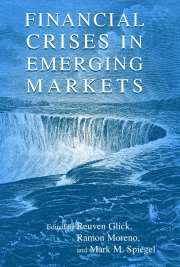Book contents
- Frontmatter
- Contents
- Preface
- Contributors
- 1 Financial Crises in Emerging Markets: An Introductory Overview
- PART I DETERMINANTS AND PROPAGATION OF FINANCIAL CRISES
- 2 Banking and Currency Crises: How Common Are Twins?
- Discussion
- 3 Multiple Equilibria, Contagion, and the Emerging Market Crises
- Discussion
- 4 How Are Shocks Propagated Internationally?
- Discussion
- PART II CAPITAL FLOWS AND REVERSALS
- PART III INSTITUTIONAL FACTORS AND FINANCIAL STRUCTURE
- PART IV POLICY RESPONSES
- Index
2 - Banking and Currency Crises: How Common Are Twins?
Published online by Cambridge University Press: 04 August 2010
- Frontmatter
- Contents
- Preface
- Contributors
- 1 Financial Crises in Emerging Markets: An Introductory Overview
- PART I DETERMINANTS AND PROPAGATION OF FINANCIAL CRISES
- 2 Banking and Currency Crises: How Common Are Twins?
- Discussion
- 3 Multiple Equilibria, Contagion, and the Emerging Market Crises
- Discussion
- 4 How Are Shocks Propagated Internationally?
- Discussion
- PART II CAPITAL FLOWS AND REVERSALS
- PART III INSTITUTIONAL FACTORS AND FINANCIAL STRUCTURE
- PART IV POLICY RESPONSES
- Index
Summary
INTRODUCTION
The joint occurrence of banking and currency crises associated with the recent Asian financial turmoil has drawn renewed attention to the interrelationship between these two phenomena. Banking and currency crises appeared to arise virtually at the same time in Thailand, Indonesia, Malaysia, and Korea in 1997–1998. In fact, the incidence of “twin” crises has been relatively widespread, occurring in such diverse parts of the world as Latin America in the early and mid–1980s and Scandinavia in the early 1990s.
There are good theoretical reasons to expect connections between currency and banking crises, especially because foreign assets and liabilities are a component in commercial banks' balance sheets. In principle, the causality between bank and currency crises may run in either direction. As we discuss in Section 2.2, bank crises may lead to currency crises under some circumstances, while under other conditions currency crises may cause bank crises. Moreover, some recent literature does not distinguish between the two phenomena and regards them as simultaneous manifestations of underlying common factors (Change and Velasco, 1999).
Most of the empirical literature on currency and banking crises has involved analyzing the determinants of each type of crisis independently of the other. Little empirical work to date has systematically investigated the association of bank and currency crises. The few exceptions (e.g., Kaminsky and Reinhart, 1999; Rossi, 1999) typically restrict their data sets to a limited number of countries experiencing crises.
- Type
- Chapter
- Information
- Financial Crises in Emerging Markets , pp. 35 - 69Publisher: Cambridge University PressPrint publication year: 2001
- 61
- Cited by

